One million Canadians 65 and older are now able to see a dentist under the Canadian Dental Care Plan (CDCP).
While applications have been accepted for the age group since December 2023, patients are now able to have their dental costs covered under the program.
Those 65 and older can also apply online for coverage under the federal plan. More changes are expected by June, including allowing anyone under 18 to qualify for coverage. All other eligible Canadians will be able to apply for coverage in 2025.
Ottawa estimates the program to cost $13 billion over the next five years.
How can I find a dentist with the CDCP?
The federal government has put Sun Life Insurance Company in charge of the program. It has an online database where you can search for a dentist or service near you. The search uses a 50-kilometre radius. Sun Life says that new providers are signing up each day. If you’re not able to find one near you, it advises checking in a few days.
What if my dentist is not on the list?
Not all dentists in Canada are participating in the CDCP. If your dentist has not opted to participate, that doesn’t mean you have to switch dentists. Ottawa says that dentists will be able to directly bill Sun Life for services on a claim-by-claim basis, starting on July 8. It’s best to talk to your dentist and see if they are willing to directly bill Sun Life. Keep in mind that the reimbursement through the CDCP may not cover all the costs associated with your oral health care.
Why are not all dentists participating?
The Canadian Dental Association (CDA) says that it has concerns over “gaps” in the CDCP, which could make oral health professionals cautious about signing onto the program. In a survey, the CDA found that 61 percent of dentists in Canada would not participate in the CDCP unless changes were made. One concern the organization expressed was the ability of patients to pick their dentist and that the program “not disrupt Canada’s existing oral health care system.” CDA has also said it is concerned over the pre-authorization requirement for medically needed care.
Is there a cost?
There is no cost to apply for coverage. However, the CDCP will only pay a percentage of the dental service fee. This percentage is lower than most provincial oral health organizations recommend, which could mean patients are left paying the difference between the CDCP amount and what the dentist actually charges. Families with an adjusted net income between $70,000 and $89,999 could have to pay additional charges.
What is covered under the CDCP?
The CDCP covers a range of dental care and oral health services, including:
- preventive services, including scaling (cleaning), sealants, and fluoride
- diagnostic services, including examinations and X-rays
- restorative services, including fillings
- endodontic services, including root canal treatments
- prosthodontic services, such as complete dentures or partial removable dentures
- periodontal services, including deep scaling
- oral surgery services, including extractions
The government says that some services may need pre-authorization. These procedures will not be covered until November, the website said.
How does the program work for separated or divorced families?
The net family income is calculated based on marital status. That means if you are separated from a spouse, the family net income is based on both parents’ incomes, the CDA said. If your combined income is over the $90,000 threshold, your children will not be eligible for the CDCP. Moreover, both spouses need to have completed a recent tax return to qualify.
Do I have to reapply each year?
Canadians will need to meet eligibility criteria each year to continue being covered under the CDCP. Ottawa said it will be providing information on the annual reassessment process later.
